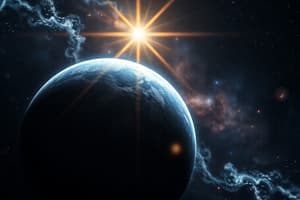Podcast
Questions and Answers
What is the outermost solid layer of the Earth composed of?
What is the outermost solid layer of the Earth composed of?
- Hot, viscous rock
- Varied solid rocks and minerals (correct)
- Liquid iron and nickel
- Molten iron and nickel
What is the process by which water evaporates from oceans, lakes, and rivers?
What is the process by which water evaporates from oceans, lakes, and rivers?
- Condensation
- Precipitation
- Runoff
- Evaporation (correct)
What percentage of the Earth's surface is covered by oceans?
What percentage of the Earth's surface is covered by oceans?
- 81%
- 71% (correct)
- 91%
- 61%
What is the dominant gas in the Earth's atmosphere?
What is the dominant gas in the Earth's atmosphere?
What is the layer of the atmosphere where weather occurs?
What is the layer of the atmosphere where weather occurs?
What is the region between Mars and Jupiter that contains small rocky bodies?
What is the region between Mars and Jupiter that contains small rocky bodies?
What is the purpose of a telescope in astronomy?
What is the purpose of a telescope in astronomy?
What is the artificial satellite in low Earth orbit?
What is the artificial satellite in low Earth orbit?
What is the process by which plates move apart, resulting in new crust formation?
What is the process by which plates move apart, resulting in new crust formation?
What is the center of the Solar System?
What is the center of the Solar System?
Flashcards are hidden until you start studying
Study Notes
Earth's Structure
- The Earth is composed of several layers:
- Crust: outermost solid layer, varied in thickness and composition
- Mantle: thick layer of hot, viscous rock beneath the crust
- Outer Core: liquid iron-nickel alloy, responsible for generating magnetic field
- Inner Core: solid, iron-nickel alloy at the center of the Earth
Plate Tectonics
- Theory that explains the movement of the Earth's crust:
- Lithosphere: broken into several large plates that float on the mantle
- Plates move relative to each other, resulting in geological activity:
- Divergent motion: plates move apart, new crust forms
- Convergent motion: plates collide, resulting in subduction or collision
- Transform motion: plates slide past each other horizontally
Earth's Water Systems
- Hydrologic cycle: continuous process of water circulation between the Earth and atmosphere:
- Evaporation: water evaporates from oceans, lakes, and rivers
- Condensation: water vapor cools, forming clouds and precipitation
- Runoff: precipitation that flows over the land, returning to bodies of water
- Oceans:
- Cover approximately 71% of the Earth's surface
- Salinity: measure of salt concentration in seawater
- Ocean currents: driven by wind, tides, and thermohaline circulation
Earth's Atmosphere
- Composition:
- Nitrogen (78%): dominant gas
- Oxygen (21%): essential for life
- Other gases: argon, carbon dioxide, water vapor, and others
- Atmospheric layers:
- Troposphere: lowest layer, where weather occurs
- Stratosphere: stable layer, where ozone layer is located
- Mesosphere: layer where meteors burn up
- Thermosphere: layer where aurorae occur
- Exosphere: outermost layer, where atmosphere interacts with space
Space Science
- Celestial bodies:
- Stars: massive, luminous balls of gas
- Galaxies: large systems of stars, gas, and dust
- Planets: rocky or gaseous bodies that orbit stars
- Moons: natural satellites that orbit planets
- Solar System:
- Consists of 8 planets (Mercury to Neptune), 5 dwarf planets, and other smaller bodies
- Sun: center of the Solar System, providing light and heat
- Asteroid belt: region between Mars and Jupiter, containing small rocky bodies
- Kuiper belt: region beyond Neptune, containing icy bodies and comets
Astronomy and Space Exploration
- Telescopes: instruments used to study celestial objects:
- Reflector telescopes: use mirrors to focus light
- Refractor telescopes: use lenses to focus light
- Space exploration:
- NASA: National Aeronautics and Space Administration (USA)
- Spacecraft: vehicles designed to travel through space
- International Space Station: habitable artificial satellite in low Earth orbit
Studying That Suits You
Use AI to generate personalized quizzes and flashcards to suit your learning preferences.





